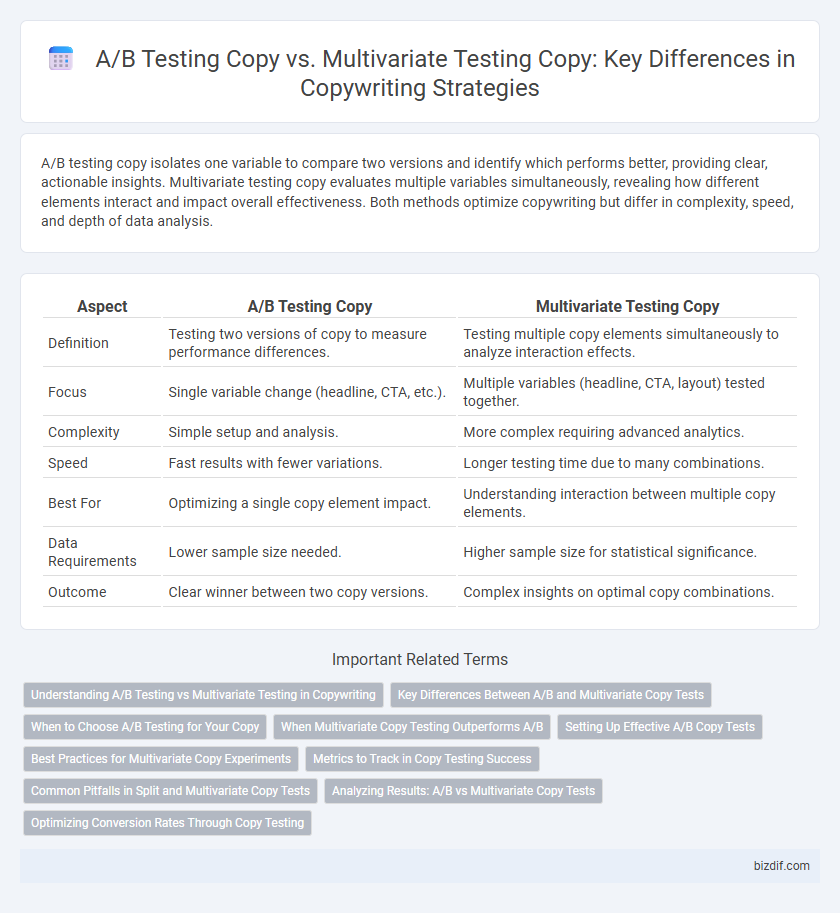A/B testing copy isolates one variable to compare two versions and identify which performs better, providing clear, actionable insights. Multivariate testing copy evaluates multiple variables simultaneously, revealing how different elements interact and impact overall effectiveness. Both methods optimize copywriting but differ in complexity, speed, and depth of data analysis.
Table of Comparison
| Aspect | A/B Testing Copy | Multivariate Testing Copy |
|---|---|---|
| Definition | Testing two versions of copy to measure performance differences. | Testing multiple copy elements simultaneously to analyze interaction effects. |
| Focus | Single variable change (headline, CTA, etc.). | Multiple variables (headline, CTA, layout) tested together. |
| Complexity | Simple setup and analysis. | More complex requiring advanced analytics. |
| Speed | Fast results with fewer variations. | Longer testing time due to many combinations. |
| Best For | Optimizing a single copy element impact. | Understanding interaction between multiple copy elements. |
| Data Requirements | Lower sample size needed. | Higher sample size for statistical significance. |
| Outcome | Clear winner between two copy versions. | Complex insights on optimal copy combinations. |
Understanding A/B Testing vs Multivariate Testing in Copywriting
A/B testing in copywriting compares two versions of a single element to identify which performs better, focusing on one variable at a time for clear, actionable insights. Multivariate testing evaluates multiple variables simultaneously to understand how different combinations interact and influence user behavior, providing a more complex but comprehensive analysis. Choosing between A/B and multivariate testing depends on the campaign's complexity, traffic volume, and the goal of isolating or optimizing multiple copy elements.
Key Differences Between A/B and Multivariate Copy Tests
A/B testing copy compares two versions of a single variable, such as headlines or call-to-action phrases, to determine which performs better based on user engagement metrics. Multivariate testing copy evaluates multiple variables simultaneously, analyzing combinations of headlines, images, and button colors for their collective impact on conversion rates. The key difference lies in A/B testing's simplicity and speed versus multivariate testing's complexity and deeper insights into interactions between multiple elements.
When to Choose A/B Testing for Your Copy
Choose A/B testing for your copy when you want clear, straightforward results by comparing two variants, making it ideal for optimizing headlines, call-to-action phrases, or email subject lines. This method is most effective when testing a single element or a limited change to understand specific impact on user engagement or conversion rates. Use A/B testing in scenarios with moderate traffic to yield statistically significant insights faster than complex multivariate testing designs.
When Multivariate Copy Testing Outperforms A/B
Multivariate testing copy outperforms A/B testing when multiple variables in headlines, calls-to-action, or body text interact to significantly impact conversion rates. It allows marketers to evaluate combinations of copy elements simultaneously, revealing the most effective mix of messaging strategies. This method is especially valuable for complex campaigns where optimizing individual components alone cannot capture the synergistic effects on audience engagement.
Setting Up Effective A/B Copy Tests
Setting up effective A/B copy tests involves creating two distinct versions of a single variable, such as headlines or call-to-action phrases, to measure which performs better in driving conversions or engagement. Precise segmentation of the audience and tracking key performance indicators (KPIs) like click-through rates and bounce rates ensure reliable data collection and insightful comparison. Consistent test conditions and sufficient sample size reduce bias, enabling clear conclusions about the impact of specific copy changes on user behavior.
Best Practices for Multivariate Copy Experiments
Multivariate testing copy demands precise hypothesis formulation to evaluate multiple variables simultaneously, ensuring accurate attribution of performance differences. Employing a sufficient sample size and testing duration enhances statistical validity, minimizing false positives in complex copy variations. Prioritize clarity in variable distinctions and consistent tracking mechanisms to optimize insights and refine copy based on high-impact element combinations.
Metrics to Track in Copy Testing Success
Conversion rate remains the most critical metric in both A/B testing and multivariate testing copy, as it directly reflects the effectiveness of the tested variations in driving user actions. Engagement metrics such as click-through rate (CTR), bounce rate, and average session duration provide deeper insights into how users interact with different copy elements. Tracking these metrics alongside revenue per visitor and customer acquisition cost allows for a comprehensive assessment of copy performance in optimizing marketing ROI.
Common Pitfalls in Split and Multivariate Copy Tests
Common pitfalls in A/B testing copy include insufficient sample sizes that yield inconclusive results and testing too many variables simultaneously, which confuses data analysis. Multivariate testing copy risks overcomplicating experiments by assessing numerous elements at once, causing longer test durations and diluted statistical significance. Both methods require careful planning to avoid misleading conclusions and ensure valid insights into copy performance.
Analyzing Results: A/B vs Multivariate Copy Tests
Analyzing results in A/B testing copy involves comparing performance metrics between two variations to identify the most effective headline, call-to-action, or messaging element. Multivariate testing copy focuses on assessing multiple variables simultaneously to understand how different combinations impact user engagement and conversion rates. While A/B tests provide clear insights on individual changes, multivariate tests deliver deeper data on interaction effects, enabling more strategic copy optimization.
Optimizing Conversion Rates Through Copy Testing
A/B testing copy isolates and compares two variations of a single element to determine which yields higher conversion rates, making it ideal for focused optimization. Multivariate testing copy evaluates multiple variables simultaneously, uncovering interactions between headlines, call-to-actions, and body text to identify the most effective combination for maximizing conversions. Leveraging data-driven insights from both methods enhances the precision of copy adjustments, driving significant improvements in conversion rate optimization.
A/B Testing Copy vs Multivariate Testing Copy Infographic

 bizdif.com
bizdif.com